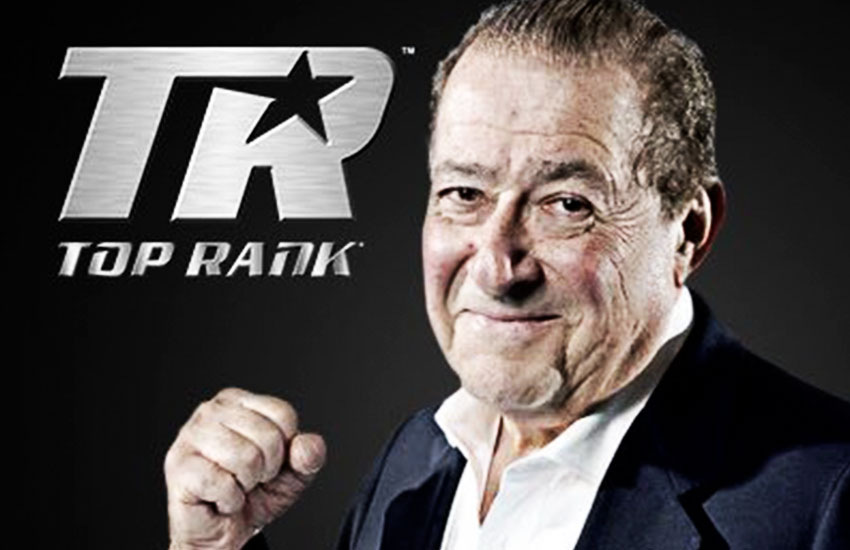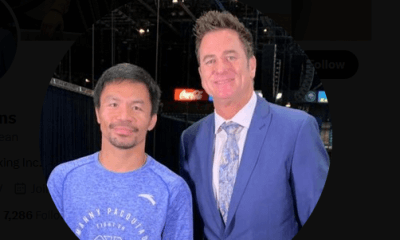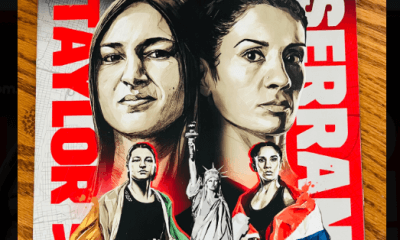Featured Articles
Bob Arum Takes Another Dip Into The Heavyweight Pond

The secret of Bob Arum’s incredible longevity in boxing, a voracious, cannibalistic sport that tends to devour its young and weak and casually gnaw on the remnants of its old and infirm, is the 85-year-old’s ability to recognize and take advantage of coming changes before they happen, almost before anyone else knows those changes are needed.
It is that remarkable sense of intuition, perhaps more than anything else, that has enabled Arum – a Harvard Law School graduate and former member of U.S. Attorney General Bobby Kennedy’s Justice Department in the 1960s – to outsmart and outlast a couple of generations of promotional competitors who made the mistake of assuming this old, or at least aging, dog was incapable of learning new tricks.
“Everybody looks for the easy money and the easy way out, including myself,” the Top Rank founder and chairman said in the spring of 2007, when he still was a relatively spry pup of 75. “But I find it doesn’t work anymore. You have to fish where the fish are.”
This Saturday night, with the pond in Lincoln, Neb., stocked with trout eager to be hooked by another in-state appearance by Nebraska’s own Terence Crawford, that particular bit of Arumesque sagacity again will be certified. Crawford (31-0, 22 KOs), the WBC and WBO super lightweight champion, will attempt to fully unify the 140-pound title against IBF and WBA ruler Julius Indongo (22-0, 11 KOs), and he figures to do so before a raucous, pro-Crawford sellout crowd of 15,500 in the Pinnacle Bank Arena. That the favored Crawford figures to make an even stronger case for himself as a superstar attraction with a TV audience in the millions, thanks to the scheduled 12-round bout being shown on basic-cable ESPN instead of HBO, is another testament to Arum’s master plan of going back to the future. From 1980 to ’95, 767 of the 2,000-plus fight cards staged by Arum’s company were televised via Top Rank Boxing on ESPN, which served to make any number of his client-fighters primed and ready to graduate to premium-cable and pay-per-view.
But it is the presence of a non-televised, eight-round heavyweight bout on the undercard that signals another potentially bold move into a different but still somehow familiar direction by Arum, whose promotional career began with arguably the greatest of all heavyweights, Muhammad Ali, and featured a nice run with comebacking elder statesman George Foreman. While he has taken occasional fliers on other heavyweights (Ray Mercer, Hasim Rahman), Arum otherwise has been mostly known for his showcasing of fighters in lower weight classes (Sugar Ray Leonard, Manny Pacquiao, Thomas Hearns, Floyd Mayweather Jr., Marvelous Marvin Hagler, Oscar De La Hoya, Miguel Cotto and Michael Carbajal, among others). In recent years, the Top Rank lineup has been primarily dotted with Hispanic fighters, an acknowledgment of Arum’s belief that that fan base is the deepest and most ardent in boxing.
No one is ready to pronounce the return to action, after a 20-month period of inactivity, of Arum’s recent signee, Bryant Jennings, as a cannonball splash into the deep end of the heavyweight pool by a promoter who occasionally makes impetuous statements but does virtually nothing else without first assessing the risk-reward factor and possible down-the-road ramifications. Indeed, Arum isn’t even Jennings’ sole promoter; the 32-year-old Philadelphian, who is coming off two consecutive losses in addition to the long layoff, is co-promoted by Antonio Leonard. But should Jennings (19-2, 10 KOs) look good in dispatching journeyman Daniel Martz (15-4-1, 12 KOs), and follows that up with another tuneup victory in November or December … well, who knows? Arum also co-promotes (with Dean Lonergan and David Higgins of Duco Events) Joseph Parker (23-0, 18 KOs), the New Zealander who defends his WBO belt against Hughie Fury (20-0, 10 KOs) on Sept. 23 in Manchester, England.
It is no great stretch of the imagination to foresee a title bout between Parker and a resuscitated Jennings in the spring of 2018, or possibly even a rematch between Parker and Andy Ruiz Jr. (29-1, 19 KOs), an American of Mexican descent and third member of Top Rank’s heavyweight troika who lost a majority decision for the vacant WBO crown on Dec. 10, 2016.
“You would think so,” Jennings said of the possibility that a matchup of he and Parker could be done with minimum muss and fuss, barring the stubbing of a toe by either somewhere along the way. “Making that fight, to me, is very possible. Don’t be surprised if you see that fight in the next six months to a year.”

Arum, who sounded a bit under the weather during a telephone conversation last weekend, said between coughs that a Parker-Jennings pairing is or fairly soon could be on the drawing board.
“We were doing a fight in New York and Antonio and James Prince (who co-manages Jennings along with attorney Josh Dubin) brought Jennings to see me,” Arum related. “I really took a liking to him. He’s a very intelligent guy, a clean-living guy. We think that if he goes back on the board, he can develop into a real threat. There’s four titles out there. We can make a run with Jennings in the short term for one of those titles.
“Of course, for (Parker-Jennings) to happen, Parker has to get past Hughie Fury. But if we’re successful with Parker, and successful with Bryant, I would match them in the spring on ESPN.”
One has to wonder if Top Rank’s expanded foray back into the big-boy weight class (it should be noted that TR has promoted Ruiz for the duration of his eight-year pro career) owes, at least in part, to the Aug. 2 retirement announcement by 41-year-old Wladimir Klitschko, who joins older sibling Vitali on the sideline after 14 nearly unbroken years of their vise grip on the division. When Wlad was upset on a unanimous decision against Tyson Fury (Hughie’s older brother) to end his second title reign, which had lasted a decade, on Nov. 28, 2015, one smart-alecky boxing writer (uh, that would be me) suggested that the barbarians no longer were pounding in frustration upon the gate, they had at last broken through to the throne room.
Sometimes palaces are just like an ordinary Joe’s apartment in that a new look can be invigorating, even if it involves nothing more than moving the same furniture around. With the Klitschkos gone – the suspicion here is that they’ll be more appreciated as time goes by – the immediate effect is to provide a jolt of energy and hope to a heavyweight division that always had been characterized as the locomotive that powered boxing’s train.
“Maybe,” Arum said when asked if the new heavyweight reality will be better than the one just past, and particularly for Top Rank. “It depends on the fighters we have. We’re not adverse to promoting heavyweights.
“The center has moved from Europe and Germany with the Klitschkos to around the world – London with Anthony Joshua and into the United States and other English-speaking countries, like New Zealand. It’s becoming more relevant and a lot easier to sell in those countries. There’s also the difference in time. An English fighter like Joshua – who’s still fighting exclusively in Europe, obviously, although he’s supposed to do some fights here in the U.S. – is more accessible because the language is the same and the English have a tradition of accommodating American television.
“It’s good to have some Americans out there (most notably WBC champion Deontay Wilder, but also Jennings, rising prospect Jarrell “Big Baby” Miller and several possibly recycled Klitschko victims). But, obviously, our best American (potential) heavyweights are playing in the NFL and the NBA.”
Antonio Leonard, Jennings’ co-promoter, understands why Arum could view the onetime high school football star as a lottery ticket that just might pay off. Leonard considers the heavyweight division to now be “wide-open,” and, well, you can’t win if you don’t play.
“It was a collaboration with all of them,” he said of Top Rank’s decision to climb aboard the Jennings bandwagon, a consensus that involved not only Arum but TR president Todd duBoef, executive Carl Moretti and matchmaker Bruce Trampler. “With as little experience as he had (17 amateur bouts and 19 in the pros), Bryant was able to go the distance with (Wladimir) Klitschko and give a good account of himself. And Klitschko was on the verge of knocking Joshua out. That tells me Joshua can be beaten. They all can. I don’t see any reason why Bryant can’t win twice before the year is out. He’s always in shape. He’s a hell of an athlete, maybe the best athlete in the division.”
And if the current heavyweight experiment flops? Make no mistake, Arum, who was inducted into the International Boxing Hall of Fame in 1999, has taken the requisite steps to ensure that the company he founded in 1973 survives in the long term. He has stayed ahead of the technological curve, for one thing (the Jennings-Martz bout will be streamed live via the Top Rank app) and he has delegated authority as the need arose to trusted and capable lieutenants, the failure to do so being a root cause for the decaying empire of his longtime arch-rival, Don King, whose rise and fall was marked by seat-of-the-pants immediacy. Arum still has an enemies’ list – more recent irritants include Al Haymon and Richard Schaefer, and he remains insistent that fighters who are their own promoters serve neither their athletic nor business best-interests – but he has done it his way throughout a now-51-year promotional journey (the first fight he staged was Ali’s wide, 15-round heavyweight title defense against rugged challenger George Chuvalo on March 29, 1966, in Toronto’s Maple Leaf Gardens).
Arum is still having fun re-inventing the wheel. When some of his mainstays exited their respective primes or retired, and when De La Hoya and Mayweather bolted, he simply plugged in a Cotto or a Pacquiao and kept rolling. If that wheel that keeps going round and round again has come around to another go with heavyweights, so be it. It won’t – can’t — be like the good old days with the young Ali and the ancient Foreman, but so what?
The future always has belonged to the adventurous, even if the adventurer is an octogenarian.
Check out more boxing news on video at The Boxing Channel.
-

 Featured Articles3 weeks ago
Featured Articles3 weeks agoVito Mielnicki Jr Whitewashes Kamil Gardzielik Before the Home Folks in Newark
-

 Featured Articles4 days ago
Featured Articles4 days agoResults and Recaps from New York Where Taylor Edged Serrano Once Again
-

 Featured Articles1 week ago
Featured Articles1 week agoFrom a Sympathetic Figure to a Pariah: The Travails of Julio Cesar Chavez Jr
-

 Featured Articles3 days ago
Featured Articles3 days agoResults and Recaps from NYC where Hamzah Sheeraz was Spectacular
-

 Featured Articles4 weeks ago
Featured Articles4 weeks agoCatching Up with Clay Moyle Who Talks About His Massive Collection of Boxing Books
-

 Featured Articles1 week ago
Featured Articles1 week agoCatterall vs Eubank Ends Prematurely; Catterall Wins a Technical Decision
-

 Featured Articles4 days ago
Featured Articles4 days agoPhiladelphia Welterweight Gil Turner, a Phenom, Now Rests in an Unmarked Grave
-

 Featured Articles3 weeks ago
Featured Articles3 weeks agoMore Medals for Hawaii’s Patricio Family at the USA Boxing Summer Festival



















